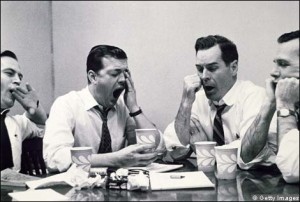YAWNING
III. Evolution and Purpose
A. Phylogenetically conserved
1. reptiles, birds, mammals
a. fish
2. conservation implies functional significance
a. Commonly associated with boredom, tiredness,
and being overworked
i. but what is the function?
B. Multiple triggers/functions for Yawning
1. Arousal States
2. Thermoregulation
3. Circadian Rhythms
4. Yawn Contagion
C. Role in Arousal States
1. frequently observed during transition from one state of arousal to another
a. inspiration and mouth opening are preceded by cortical arousal
b. Yawning Ó˝ circulation
i. Yawning Þ˝ heart rate
ii. mechanically stimulate the carotid artery
1) via muscle stretching Þ neck compression
iii. promoting ˝ cortical arousal
1) potential ˝ delivery of
adenosine or catecholamines
2. linked with Fight or Flight responses
a. nervous or fearful of a particular situation
i. nervousness: perception of an impending need for action
1) paratroopers often yawn right before they jump
b. defense mechanism
i. ôalarm signalö warning that it is not safe to fall asleep
ii. display dominance or threaten enemies
1) showing incisor and canine teeth
a) Guinea pigs and Baboons
3. Circadian regulation of Yawning in relation to Sleep-Wake Cycles
a. Yawning is most frequent at Awakening
i. occurs with pandiculation (stretching)
ii. sleep-wake = transitional arousal states
b. as Sleep is about to occur (without stretching)
i. appear to have opposite functions
c. Linked to circadian rhythmicity by phase relationships
i. phase advance Þ Wake early Þ˛ yawns
ii. phase delay Þ to Bed late Þ˝ yawns
1) Not correlated with sleep duration
a) Wake early vs Bed late: identical
sleep latency, durationand efficiency
b) phase delay: Awaken closer to To nadir
Sleep durning earlier part of To cycle
2) Yawning frequency Þ˛ across day time
a) lowest in early evening
D. Role in Thermoregulaion
1. compensatory cooling mechanism
a. ˝ yawning when ˝ To of brain/body
i. ˛ yawning as Tobrain/body returns to normal
ii. 1o determinates of Tobrain
= blood flow rate, Toblood supply,
metabolic thermogenesis
1) ˝ heart rate during yawning
a) enables cooler blood to pass
through warmer brain
more rapidly Þ convection cooling
iii. similar effects D2 agonists.
1) Low doses Ó˝ yawning
2) high doses Ó˛ Tob & yawning
E. Yawn Contagion
1. different from Spontaneous Yawning
a. known in a Limited number of animal species
i. dogs, macaques, baboons, chimpanzees, humans
2. Involves Mirror Neurons - Visuo-motor neurons
a. Active when observing action performed by another individual
i. Developmental specialization associated with empathy
ii. may be Evolutionarily old
1) many species from fish Þ humans
learn by watching others
b. Impaired in children with autism spectrum disorder,
PTSD, and schizophrenia
c. Unilateral activation of Brodmannĺs area 9
i. Portion of the right inferior frontal gyrus
1) includes mirror neuron system (MNS)
3. Yawn contageon activates pars opercularis of inferior frontal gyrus
a. anterior part of inferior parietal lobule
b. superior temporal sulcus
c. posterior cingulate
d. bilateral superior temporal sulcus
e. ventromedial prefrontal cortex
F. All Functions include
1. Increased blood flow to brain
2. Decrease in Tobrain
3. Increase in alertness
4. Communicative purpose to replicate in group
IV. Sensory Afferents to Yawn
